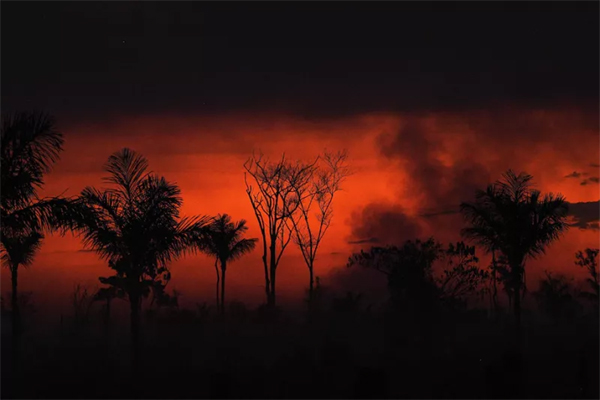
n Mato Grosso state, Brazil, on Aug. 11, 2020. (Carl De Souza/AFP/)
Mac Margolis , The Washington Post
RIO
EnergiesNet.com 02 23 2022
Latin America’s caudillos dealt with unflattering truths by jailing critics and burning books. Brazilian President Jair Bolsonaro pulls the plug.
From shutting down speed trap radars on the country’s deadly highways to hiding data on a surging pandemic death toll, no problem is too big for the Americas’ denialist in chief to try to bury.
Perhaps nothing speaks more to this willful myopia than the Bolsonaro administration’s handling of environmental emergencies. In three years, his government has gutted spending on science and technology, left Amazon research in penury and pauperized the Environment Ministry.
Yet Bolsonaro’s favorite target has been the National Institute for Space Research (INPE), which is tasked with tracking deforestation. In 2019, Bolsonaro summarily fired the institute’s director after he reported a surge in Amazon clear-cutting. Now the landmark Cerrado monitoring program is under assault.
The move further threatens the country’s vast savanna, even as Big Ag carpets the frontier with export crops and cattle. Another 3,300 square miles or so, an area roughly the size of Puerto Rico, was razed in the year ending in July 2021. If INPE fails to secure alternative financing, the Cerrado money runs out in April.
With the Amazon in flames, the fate of the savanna might seem a lesser emergency. Scientists know better. The country’s second-largest biome, covering 24 percent of Brazil, is considered the world’s most biodiverse savanna. Several of South America’s biggest rivers, including the Araguaia and the Xingu, traverse these sprawling tablelands. The savanna’s tree roots sop up the wet season’s rains and decants the runoff across the midriff of South America, a continental aquifer irrigating this fertile area.
Calls to extend the Amazon “zero deforestation” mandate to the Cerrado, a global bread basket that doubles as Brazil’s economic engine, may be misguided. Yet sustainable agriculture is essential. This means curbing cutting, burning and land grabbing to prevent the frontier bounty from falling into ruin. No institution looks closer than Latin America’s marquee space institute, which works year round to render a faithful, nearly real-time picture of habitats under siege.
For five decades, INPE has tracked the changing Brazilian countryside, keeping close watch over the Amazon and the Cerrado. What began as a low-tech survey, with teams of analysts poring over hard copies of pictures snapped from the skies, has evolved into expert-driven analysis of high-resolution images captured by orbiting satellites such as Amazonia 1.
INPE has kept an annual inventory of deforestation (Prodes) since 1998 and, since 2004, has deployed an emergency alert system (Deter) that detects fires and felling nearly as they unfold.
The sharper visualization gives Brazilian authorities a powerful tool to intervene and dispatch inspectors to the field to stop environmental outlaws in the act. The result: Brazil reduced Amazon felling by 83 percent between 2004 and 2012, even as the economy surged.
The institute’s monitoring platforms have also become part of the tool kit of Brazilian soft power, helping other tropical nations ramp up their own habitat surveillance systems. INPE data has been cited in some 1,200 indexed scientific journals and scores of dissertations.
What escapes no one is that the defunding of INPE comes amid international outcry over spiking deforestation, which the government has proved helpless to contain, when it hasn’t actively encouraged it. Deforestation has increased dramatically since 2018.
You wouldn’t know that by the bromides from government officials. In his international debut, Bolsonaro’s new environment minister — whose predecessor quit under a cloud — touted Brazil’s green commitments at COP26 in Glasgow, while failing to mention the latest data showing a surge in Amazon deforestation.
Brazil’s legacy military leaders, to whom Bolsonaro swears fealty, might be scandalized. The generalissimos (1964-1985) weren’t out to save Amazonia. Rather, they meant to keep it from foreign clutches and harness science to remake Latin America’s biggest underachiever into a wheelhouse of technological innovation.
They stacked leading research centers with foreign-trained PhDs, engineers and computer geeks, hoping to transform INPE into a developing world NASA. The space aces went on to turn their country into the benchmark for environmental monitoring in the tropics. Now Bolsonaro risks being remembered as the leader who looked the other way.
_________________________________
Mac Margolis, an adviser to the Brazilian Igarapé Institute, writes frequently about Latin America. He is the author of “The Last New World: The Conquest of the Amazon Frontier.” Energiesnet.com does not necessarily share these views.
Editor’s Note: This article was originally published by The Washington Post, on February 16, 2022. All comments posted and published on EnergiesNet.com, do not reflect either for or against the opinion expressed in the comment as an endorsement of EnergiesNet.com or Petroleumworld.
Use Notice: This site contains copyrighted material the use of which has not always been specifically authorized by the copyright owner. We are making such material available in our efforts to advance understanding of issues of environmental and humanitarian significance. We believe this constitutes a ‘fair use’ of any such copyrighted material as provided for in section 107 of the US Copyright Law. In accordance with Title 17 U.S.C. Section 107. For more information go to: http://www.law.cornell.edu/uscode/17/107.shtml.
EnergiesNet.com 02 23 2022












